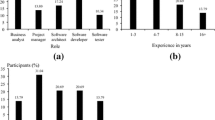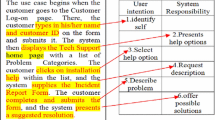Abstract
This paper presents SCRAM–CK, a method to elicit requirements by means of strong user involvement supported by prototyping activities. The method integrates two existing approaches, SCRAM and CK theory. SCRAM provides the framework for requirements management, while CK theory provides a framework for reasoning about design and its evolution. The method is demonstrated with the definition and refining of requirements for the BioVeL web toolkit. The objective of BioVeL is to allow scientists to understand, run, modify and construct workflows for data analysis with minimal training using a web-based interface. The proposed method is supported by prototyping activities for gathering user feedback, and refining requirements and design proposals. Using this method, the prototypes evolved from simple workflow execution enablers to include more complex functionalities for reviewing, modifying and building workflows in later versions. This paper presents a contribution to the application of techniques for requirements engineering. SCRAM–CK is an amalgamated method that combines a user-centred continuous refinement approach with support for design evolution through prototyping. The paper also shows the influence of the requirements engineering process in the evolution of design proposals.








Similar content being viewed by others
Notes
This was the platform where the BioVeL web toolkit was first deployed (http://aws.amazon.com/).
References
Al Balushi TH, Sampaio PRF, Loucopoulos P (2013) Eliciting and prioritizing quality requirements supported by ontologies: a case study using the ElicitO framework and tool. Expert Syst 30(2):129–151
Alexander I, Beus-Dukic L (2009) Discovering requirements: how to specify products and services. Wiley, Chichester, p 457
Al-Subaie HSF, Maibaum TSE (2006) Evaluating the effectiveness of a goal-oriented requirements engineering method. Fourth international workshop on comparative evaluation in requirements engineering (CERE), September 2006, pp 8–19. doi:10.1109/CERE.2006.3
Azadegan A, Papamichail N, Sampaio P (2013) Applying collaborative process design to user requirements elicitation: a case study. Comput Ind. doi:10.1016/j.compind.2013.05.001
Bhagwanani S (2005) An evaluation of end-user interfaces of scientific workflow management systems. Master Thesis, North Carolina State University
Cheng BHC, Atlee JM, Joanne M (2007) Research directions in requirements engineering research directions in requirements engineering. In: Proceeding FOSE’07 future of software engineering. IEEE Computer Society Washington, Minneapolis, MN, pp 285–303
Clements PC (2000) Active reviews for intermediate designs (CMU/SEI-2000-TN-009). Software Engineering Institute, Carnegie Mellon University, pp 1–25. http://www.sei.cmu.edu/library/abstracts/reports/00tn009.cfm
Delnooz C, Vrijnsen L (2003) Experiences with scenarios and goal-oriented RE. LACS2003, Landelijk Architectuur Congres
Garijo D, Alper P, Belhajjame K, Corcho O, Gil Y, Goble C (2012) Common motifs in scientific workflows: an empirical analysis. In: 2012 IEEE 8th international conference on E-Science, pp 1–8. doi:10.1109/eScience.2012.6404427
Gil Y, Deelman E, Ellisman M, Fahringer T, Fox G (2007) Examining the challenges of scientific workflows. IEEE Computer 40(12):24–32
Goble C, De Roure D (2009) The impact of workflow tools on data-centric research. Data intensive computing: the fourth paradigm of scientific discovery, Microsoft Research, 2009
Goble C, Wroe C, Stevens R (2003) The myGrid project: services, architecture and demonstrator Grid Services and Architec-. In: Cox S (ed) Proceedings of UK e-Science all hands meeting 2003. University of Southampton, Southampton, p 8
Goecks J, Nekrutenko A, Taylor J (2010) Galaxy: a comprehensive approach for supporting accessible, reproducible, and transparent computational research in the life sciences. Genome Biol 11(8):R86. doi:10.1186/gb-2010-11-8-r86
Hatchuel A, Le Masson P, Weil B (2004), CK theory in practice: lessons from industrial applications. In: Marjanovic D (ed) 8th international design conference, Dubrovnik, 18–21 May 2004, pp 245–257
Hatchuel A, Weil B (2003) A new approach of innovative design: an introduction to CK theory. In: Proceedings of the international conference on engineering design (ICED’03), Stockholm, Sweden, pp 109–124
Jarke M, Loucopoulos P, Lyytinen K, Mylopoulos J, Robinson W (2011) The brave new world of design requirements. Inf Syst 36(7):992–1008. doi:10.1016/j.is.2011.04.003
Le Masson P, Hatchuel A, Weil B (2009) Design theory and collective creativity: a theoretical framework to evaluate KCP process. In: Proceedings of ICED 09, the 17th international conference on engineering design, vol 6, Design Methods and Tools (pt. 2), Palo Alto, CA, USA, 24–27 Aug 2009, pp 277–288
López C, Codocedo V, Astudillo H, Cysneiros LM (2012) Bridging the gap between software architecture rationale formalisms and actual architecture documents: an ontology-driven approach. Sci Comput Program 77(1):66–80
Loucopoulos P, Sun J, Zhao L, Heidari F (2013) A systematic classification and analysis of NFRs. In: 19th Americas conference on Information Systems (AMCIS 2013)
Mehandjiev N, Lecue F, Wajid U, Namoun A (2010) Assisted service composition for end users. In: 2010 eighth IEEE European conference on web services, IEEE, pp 131–138. doi:10.1109/ECOWS.2010.30
Mehandjiev N, Namoune A, Wajid U, Macaulay L, Sutcliffe A (2010) End user service composition: perceptions and requirements. In: 2010 eighth IEEE European conference on web services, IEEE, pp 139–146. doi:10.1109/ECOWS.2010.29
Nuseibeh B (2001) Weaving together requirements and architectures. Computer 34(3):115–119
Nuseibeh B, Easterbrook S (2000) Requirements engineering: a roadmap. In: Ghezz C, Jazayeri M, Wolf AL (eds) Proceedings of the 22nd international conference on software engineering, ICSE 2000, vol 1. Limerick Ireland, pp 35–46
Oinn T, Li P, Kell DB, Goble C, Goderis A, Hull D, Stevens R et al (2007) Taverna/my Grid: aligning a workflow system with the life sciences community. In: Taylor IJ, Deelman E, Gannon DB, Shields M (eds) Workflows for e-Science. Springer, London, pp 300–319. doi:10.1007/978-1-84628-757-2
Overmyer SP (1991) Revolutionary vs. evolutionary rapid prototyping: balancing software productivity and HCI design concerns. Center of Excellence in Command, Control, Communications and Intelligence (C3I), George Mason University, 4400 University Drive, Fairfax, Virginia
Parviainen P, Tihinen M (2007) A survey of existing requirements engineering technologies and their coverage. Int J Softw Eng Knowl Eng 17(6):827–850
Peirce SC, Hardisty AR, Preece AD, Elwyn G (2011) Designing and implementing telemonitoring for early detection of deterioration in chronic disease: defining the requirements. Health Inform J 17(3):173–190. doi:10.1177/1460458211409717
Pohl K, Sikora E (2007) COSMOD-RE: supporting the co-design of requirements and architectural artifacts. In: 15th IEEE international requirements engineering conference (RE 2007), IEEE, pp 258–261. doi:10.1109/RE.2007.25
Potts C (1999) ScenIC: a strategy for inquiry-driven requirements determination. In: Proceedings IEEE international symposium on requirements engineering, pp 58–65. IEEE Comput Soc. doi:10.1109/ISRE.1999.777985
Rago A, Marcos C, Diaz-Pace JA (2014) Assisting requirements analysts to find latent concerns with REAssistant. Autom Softw Eng. doi:10.1007/s10515-014-0156-0
Segrestin B (2009) Collaborative innovation capabilities: developing platforms through design games. In: International product development conference (Enschede)
Stevens RD, Robinson AJ, Goble CA (2003) myGrid: personalised bioinformatics on the information grid. Bioinformatics 19(Suppl 1):i302–i304. doi:10.1093/bioinformatics/btg1041
Sutcliffe AG (2002) User-centered requirements engineering. Springer, London
Sutcliffe AG (2009) On the inevitable intertwining of requirements and architecture. In: Lyytinen K, Loucopoulos P, Mylopoulos J, Robinson B (eds) Lecture notes in business information processing, 14 (Design requirements engineering: a ten-year perspective), pp 168–185
Sutcliffe AG, Ryan M (1998) Experience with SCRAM, a SCenario requirements analysis method, ICRE 1998, p 164
Swartout W, Baker R (1982) On the inevitable intertwining of specification and implementation. Commun ACM 25(7):438–440
Ure J, Rakebrandt F, Lloyd S, Khanban A, Procter R, Anderson S, Hanley J, Hartswood M, Pagliari C, Mckinstry B, Tarling A, Kidd G, Corscadden P (2009) Giving them something to hate: using prototypes as a vehicle for early engagement in virtual organizations social science computer review, November 2009, vol 27, pp 569–582 (first published on June 12, 2009)
Wolstencroft K, Haines R, Fellows D, Williams A, Withers D, Owen S, Soiland-Reyes S et al (2013) The Taverna workflow suite: designing and executing workflows of web services on the desktop, web or in the cloud. Nucleic Acids Res 41(Web Server issue):W557–W561. doi:10.1093/nar/gkt328
Yeltayeva K (2012) Usability study of the Taverna scientific workflow workbench. Master Thesis, University of Manchester
Zimmerman A, Nardi BA (2006) Whither or whether HCI: requirements analysis for multi-sited cyber-infrastructures. In: Conference on human factors in computing systems, CHI’06 extended abstracts on human factors in computing systems, ACM Press, pp 1601–1606
Acknowledgments
The BioVeL project has received funding from the European Union’s Seventh Framework Programme for research, technological development and demonstration under grant agreement no. 283359. More information at http://www.biovel.eu. The authors would like to thank the members of BioVeL who have actively participated in the requirements review activities reported in this paper, including our scientific partners: María Paula Balcazar Vargas, Sarah Bourlat, Päivi Lyytikäinen-Saarenmaa, Matthias Obst, Gerard Oostermeijer, Elisabeth Paymal, Hannu Saarenmaa, and Saverio Vicario; and our technical partners: Jonathan Giddy, Carole Goble, Robert Haines, Vera Hernandez, Robert Kulawik, Cherian Mathew, and Alan Williams. The authors wish to thank all the participants in the different training and dissemination activities, who have provided invaluable comments and feedback. Finally, the authors thank the anonymous reviewers for their feedback that helped to improve the overall quality of the manuscript.
Author information
Authors and Affiliations
Corresponding author
Appendix: Further enhancements
Appendix: Further enhancements
User feedback has been taken into account for the further enhancement of the BioVeL toolkit. Table 4 shows the mapping of the deployed versions of the toolkit along with the review events where they have been presented. The first column indicates the version number and the date of deployment. The second column lists the review events, including location and date. The third column indicates features incorporated in the version being used at each event.
The more advanced versions of the prototype were implemented, deployed and demonstrated to users, but they were not released for further testing and validation. Instead of this, the functionalities will be implemented into the final production version of the portal when and if required.
1.1 Review of prototype versions
The prototype has been used and evaluated during different review events, which can be grouped according to the scenarios described in Sect. 3.4.1.
In the demonstration scenario context, the portal has been used to demonstrate the advances of the project and its different products on two occasions. The first demonstration occurred during the presentation of advances to the member of BioVeL during the second annual project meeting. The second demonstration was performed during a formal EC review of project progress.
In the outreach scenario context, the portal has been demonstrated to scientists from different British, European and American Institutions to showcase BioVeL products and to promote and support the adoption of virtual research environments in the biodiversity research community.
In the workflow development scenario, the prototype has gradually become the medium for testing advances on workflow development in scheduled “play-days”. The play-days are online working sessions in which a workflow is tested by different users and developers. Previously, these involved the use of the Taverna workbench but now they are mostly carried out on the Portal. This prompted the further strengthening of the toolkit features for supporting different users and managing run results.
In the teaching scenario, the portal has been used in training sessions and workshops. In addition to this, the prototype has also been used in workshops for population modelling, niche modelling and ecosystems functioning.
In addition to these scenarios, the portal has been increasingly used by BioVeL partners for their day to day use, supporting the production of research papers and reports for environmental agencies.
1.2 Requirements review
The implementation of the features addressing the requirements gathered during different stages of the SCRAM–CK process has been interleaved with the activities for validation and refinement of those same requirements. This has facilitated providing a useful test platform that has allowed further enhancement of the toolkit thanks to actual feedback from workflow developers and users. Table 5 shows the mapping of the requirements to the deployed and planned versions of the toolkit. The final columns indicate the components of the BioVeL workflow web toolkit that were modified for the implementation of each feature.
Rights and permissions
About this article
Cite this article
de la Hidalga, A.N., Hardisty, A. & Jones, A. SCRAM–CK: applying a collaborative requirements engineering process for designing a web based e-science toolkit. Requirements Eng 21, 107–129 (2016). https://doi.org/10.1007/s00766-014-0212-0
Received:
Accepted:
Published:
Issue Date:
DOI: https://doi.org/10.1007/s00766-014-0212-0




